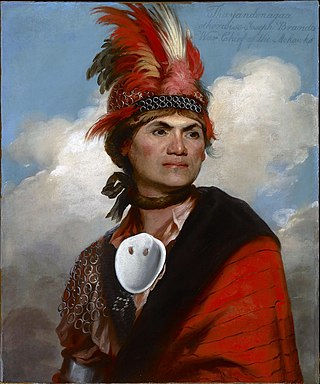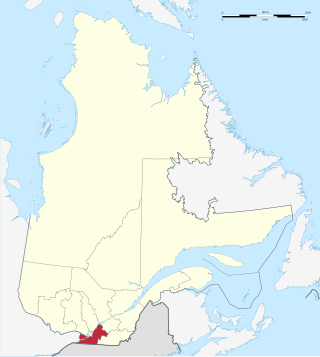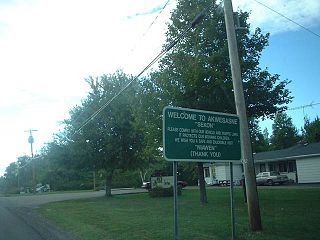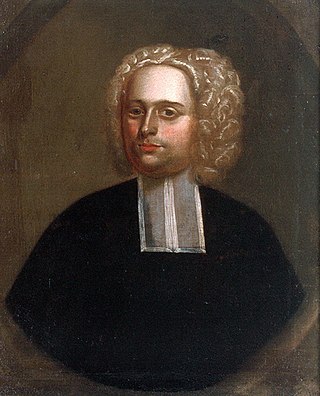Related Research Articles

The Mohawk people are the most easterly section of the Haudenosaunee, or Iroquois Confederacy. They are an Iroquoian-speaking Indigenous people of North America, with communities in southeastern Canada and northern New York State, primarily around Lake Ontario and the St. Lawrence River. As one of the five original members of the Iroquois League, the Mohawk are known as the Keepers of the Eastern Door – the traditional guardians of the Iroquois Confederation against invasions from the east.
The Oka Crisis, also known as the Kanehsatà:ke Resistance, was a land dispute between a group of Mohawk people and the town of Oka, Quebec, Canada, which began on July 11, 1990, and lasted 78 days until September 26, with two fatalities. The dispute was the first well-publicized violent conflict between First Nations and provincial governments in the late 20th century.

The Kahnawake Mohawk Territory is a First Nations reserve of the Mohawks of Kahnawá:ke on the south shore of the Saint Lawrence River in Quebec, Canada, across from Montreal. Established by French Canadians in 1719 as a Jesuit mission, it has also been known as Seigneury Sault du St-Louis, and Caughnawaga. There are 17 European spelling variations of the Mohawk Kahnawake.
Indigenous peoples in Quebec total eleven distinct ethnic groups. The one Inuit community and ten First Nations communities number 141,915 people and account for approximately two per cent of the population of Quebec, Canada.

Montérégie is an administrative region in the southwest part of Quebec. It includes the cities of Boucherville, Brossard, Châteauguay, Longueuil, Saint-Hyacinthe, Saint-Jean-sur-Richelieu, Salaberry-de-Valleyfield and Vaudreuil-Dorion.

Kanesatake is a Mohawk settlement on the shore of the Lake of Two Mountains in southwestern Quebec, Canada, at the confluence of the Ottawa and Saint Lawrence rivers and about 48 kilometres (30 mi) west of Montreal. People who reside in Kanehsatà:ke are referred to as Mohawks of Kanesatake. As of 2022, the total registered population was 2,751, with a total of about 1,364 persons living on the territory. Both they and the Mohawk of Kahnawake, Quebec, a reserve located south of the river from Montreal, also control and have hunting and fishing rights to Doncaster 17 Indian Reserve.

The Mohawk Nation at Akwesasne is a Mohawk Nation (Kanienʼkehá:ka) territory that straddles the intersection of international borders and provincial boundaries on both banks of the St. Lawrence River. Although divided by an international border, the residents consider themselves to be one community. They maintain separate police forces due to jurisdictional issues and national laws.
The Seven Nations of Canada was a historic confederation of First Nations living in and around the Saint Lawrence River valley beginning in the eighteenth century. They were allied to New France and often included substantial numbers of Roman Catholic converts. During the Seven Years' War (1756–1763), they supported the French against the British. Later, they formed the northern nucleus of the British-led Aboriginal alliance that fought the United States in the American Revolutionary War and the War of 1812.

Pierre-Louis de Lorimier, usually anglicized to Peter Loramie, was a colonial French-Canadian fur trader, British Indian agent, and Shawnee agitator. In later years, he founded what became Cape Girardeau and Bollinger Counties, Missouri. He died in Cape Girardeau and was buried there with his Indian wife.
Alexandrea Kawisenhawe Rice is an Aboriginal Canadian actress. She grew up in Brooklyn, New York. Rice is known for performances in The Twilight Saga (2008-2012) and in a series of PBS films adapted from the mystery novels of Tony Hillerman.
Dominique Ducharme, from Lachine, Quebec, was a French Canadian fur trader, settler, militia officer, and public servant.
Claude-Nicolas-Guillaume de Lorimier was an officer in the French army of Louis XV, an officer in the British Indian Department, a Member of the Parliament of Lower Canada and a fur trader and businessman. He was also known as Guillaume, Chevalier de Lorimier, Major de Lorimier, and by the Iroquois name Teiohatekon.
The Iroquois community of Kahnawake played a unique role in the Lower Canada Rebellions, part of the greater Rebellions of 1837.
Eunice Williams, also known as Marguerite Kanenstenhawi Arosen, was an English colonist taken captive by French and Mohawk warriors from Deerfield, Massachusetts in 1704. Taken to Canada with more than 100 other captives, the seven-year-old girl was adopted by a recently converted Mohawk family at Kahnawake and fully assimilated into Mohawk society. She was baptized as the Catholic "Marguerite" and renamed A'ongonte, meaning "she who has been planted as an ash tree." She eventually married a Mohawk man, François-Xavier Arosen, having several children and remaining with the Mohawk for the rest of her life. While choosing not to return to her natal family, she, along with her children, repeatedly made the trek to Deerfield to visit with her Puritan siblings over the course of her life. Her father, Rev. John Williams and her brother Samuel made numerous efforts to ransom her to no avail. Moreover, they failed to persuade her to return to Massachusetts and her birth family.
Pierre Cholenec was a French Jesuit missionary and biographer in New France. He ministered to First Nations in present-day Canada, particularly at the village of Kahnawake south of Montreal. He served as superior of the Jesuit residence in Montréal. He is known for writing multiple biographies about Kateri Tekakwitha which contributed to her canonization in 2012 by Pope Benedict XVI.

Joseph Marcoux was a Canadian Catholic missionary among the Iroquois. Fluent in Mohawk, Marcoux was also known as Tharoniakanere, "the one who looks up to the sky".

Joseph Louis Cook, or Akiatonharónkwen (Mohawk), was an Iroquois leader and commissioned officer in the Continental Army during the American Revolution. Born to an African father and an Abenaki mother in what is now Schuylerville, New York, he and his mother were taken captive in a French-Mohawk raid and taken to Kahnawake, a Mohawk village south of Montreal. They were adopted by a Mohawk family. His mother soon died and he served Catholic missionaries, learning French. He became an influential leader among the Mohawk and distinguished himself as a warrior for their allies the French during the French and Indian War.

Doncaster, officially designated as Doncaster 17 by Indian and Northern Affairs Canada, is a Mohawk Native Reserve in the Laurentides region of Quebec, Canada. It belongs to the Mohawk First Nation, specifically the people of the reserves at Kanesatake and Kahnawake.
Tracey Penelope Tekahentakwa Deer is a screenwriter, film director and newspaper publisher based in Kahnawake, Quebec. Deer has written and directed several award-winning documentaries for Rezolution Pictures, an Aboriginal-run film and television production company. In 2008, she was the first Mohawk woman to win a Gemini Award, for her documentary Club Native. Her TV series Mohawk Girls had five seasons from 2014 to 2017. She also founded her own production company for independent short work.

John Williams was a New England Puritan minister who was the noted pastor of Deerfield from 1688 to his death. He and most of his family were taken captive in the Raid on Deerfield in 1704 during Queen Anne's War. He was held by the French in Montreal for more than two years, who wanted a high-ranking French pirate in exchange. After being released in late 1706, Williams became even more notable for The Redeemed Captive (1707), his account of his captivity. It became a well-known work in the genre of captivity narratives.
References
- ↑ Alfred, Gerald R. 1995: Heeding the Voices of our Ancestors: Kahnawake Mohawk Politics and the Rise of Native Nationalism, Toronto: Oxford University Press
- ↑ Forbes, J.-Guillaume: "Saint-François-Xavier-de-Caughnawaga", Bulletin des recherches historiques, Vol. 5 (5), Mai 1899: 130-36
- 1 2 3 4 5 6 7 8 9 10 11 12 13 14 15 16 17 Faribault-Beauregard, Marthe, 1993: Mariages de Saint-François-Xavier du Sault St. Louis, 1735-1972, Montréal: Société généalogique canadienne-française
- ↑ George E. Hyde (1988). The Pawnee Indians. University of Oklahoma Press. p. 24. ISBN 9780806120942 . Retrieved 2019-06-15.
The raiders carried off such great numbers of Pawnees into slavery that in the country on and east of the upper Mississippi the name Pani developed a new meaning: slave. The French adopted this meaning, and Indian slaves, no matter from which tribe they had been taken, were presently being termed Panis.
- ↑ "Disclaimer - Electronic Collection" (PDF). epe.lac-bac.gc.ca.
- ↑ Eric Pouliot-Thisdale, "1786-1800 Oka Mission Parish registers Kanehsatà:ke, Oka", December 2015, P 105.
- ↑ "Matthieu Sossoyan: The Kahnawake Iroquois and the Lower-Canadian Rebellions, 1837-1838, McGill University, Master's Thesis in Anthropology, 1999". Archived from the original on 2007-02-09. Retrieved 2010-02-22.
- ↑ Noblesse Québécoise - Généalogie
- ↑ Diaries of Washington Vol. 1. pp. 91 American Philosophical Society
- ↑ Eric Pouliot-Thisdale (February 28, 2016). "Kanesatake census 1901 led to a premieres in names, by Eric Pouliot-Thisdale". The Eastern Door.
- ↑ McAleer, Beth and Robert V. Rice. (2005). "Y-DNA Secures Identity of Rice Mohawk Native American with Edmund Rice Haplotype," New England Ancestors, 6(4):48-50.
- ↑ ID: I09890, Name: "Theresa "Kanahwiiostah" Cook", Beth McAleer, "The Descent of Mrs. Theresa (Cook) (Leaf) Jemison from Silas Rice"Edmund Rice Assoc Fall 2005 newsletter, at rootsweb.com
- 1 2 Parkman, Ebenezer. (1769), published 1906. "The Story of the Rice Boys: Captured by the Indians August 8, 1704", Westborough Historical Society, Westborough, MA. 7pp. Download PDF
- ↑ "Ashur Rice". Edmund Rice (1638) Association. Archived from the original on 25 July 2011. Retrieved 17 July 2011.
- ↑ Eric Pouliot-Thisdale (February 28, 2016). "Kanesatake census 1901 led to a premieres in names". The Eastern Door. Retrieved February 28, 2016.
- ↑ John Demos, The Unredeemed Captive: A Family Story from Early America, New York: Alfred A. Knopf, 1994, pp. 186 and 224
- ↑ Darren Bonaparte, "The History of Akwesasne" Archived 2011-10-08 at the Wayback Machine , The Wampum Chronicles, accessed 1 Feb 2010
- ↑ Darren Bonaparte, "First Families of Akwesasne", The Wampum Chronicles, accessed 21 Feb 2010
- 1 2 John Demos, The Unredeemed Captive: A Family Story from Early America, New York: Alfred A. Knopf, 1994